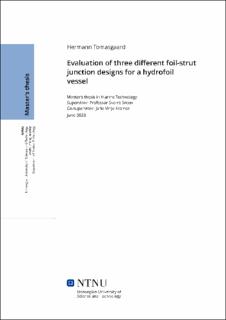| dc.contributor.advisor | Steen, Sverre | |
| dc.contributor.advisor | Kramer, Jarle Vinje | |
| dc.contributor.author | Tomasgaard, Hermann | |
| dc.date.accessioned | 2023-10-12T17:19:40Z | |
| dc.date.available | 2023-10-12T17:19:40Z | |
| dc.date.issued | 2023 | |
| dc.identifier | no.ntnu:inspera:140295966:55370577 | |
| dc.identifier.uri | https://hdl.handle.net/11250/3096206 | |
| dc.description.abstract | Selve sammenkoblingen mellom "strut" og "foil" i "hydrofoilen" har stor betydning for den totale motstanden til hydrofoil-systemer. Dette hovedsakelig på grunn av inteferensmotstand som forårsakes av det møtende grensesjiktet i hjørnet. For å minimere denne motstanden får da utformingen av dette hjørnet stor betydning. Formålet med dette studiet er derfor å evaluere tre ulike design av "strut-hydrofoil"- overganger ved hjelp av CFD simuleringer i OpenFOAM. Designene som analyseres er rett hjørne, avrundet hjørne med fillet, og til slutt, en "bulb" som omslutter hjørnet.
Som en del av studiet blir også en grundig valideringsprosess gjennomført. Simulerte resultater sammenlignes med tilgjenglige eksperimentelle data. På grunn av begrenset tilfang av eksperimentelle data spesifike for strut-hydrofoil overganger er to forsøk fra luftfartsindustrien valgt for sammenligning og validering: 2D NACA 0012 vingeprofil og vinge-vegg-overgang. Simuleringene for 2D NACA 0012 vinge profil viser akspetable resultater for løft og motstand, med avvik fra eksperimentelle data på maksimalt 5 prosent. Det er større avvik for vinge-vegg-overgangen der simuleringene relativt godt fanger opp gjennomsnittlige strømningsegenskaper, men feiler m.h.p. detaljer som virvler, og tykkelse på grensesjiktet i hjørnet.
"Fillet"-designet gir det høyeste løft til motstandsforholdet. "Bulb"-designet har lavest trykkmotstand, men høyest viskøs motstand, mens det rette hjørnet har høyest trykkmotstand. Når man vurderer sannsynligheten for kavitasjon, øker bulb designet trykkoeffisienten.
Det er klare begrensninger knyttet til CFD-simuleringene av strut-hydrofoil sammenkoblingene utført i dette studet. Noen av avvikene som identifisert i valideringsstudiet gjelder sannsynligvis også for strut-hydrofoil simuleringene. Overestimeringen av hjørneseparasjon forventes å ha større innvirkning på resultatene for designet med rett hjørne enn for designene med fillet og bulb.
Konklusjonen fra dette studiet viser tydelig at det er klare forskjeller mellom de ulike strut-hydrofoil-designene, til tross for nevnte begrensninger. CFD simuleringer, tilsvarende som gjort her, kan derfor betraktes som et godt egnet, potensielt verktøy for å analysere slike konfigurasjoner med rimelig god nøyaktighet. | |
| dc.description.abstract | The strut-hydrofoil junctions play a significant role in contributing to the total drag of hydrofoil systems, particularly due to the interference caused by the meeting boundary layers in the corner. To minimise this interference drag, the design of the junction is of great importance. Therefore, the objective of this study is to evaluate three different designs of the strut-hydrofoil junction through the use of Computational Fluid Dynamics (CFD) simulations in OpenFOAM. The junction designs under analysis include a straight T-junction, a fillet with a rounded corner, and a bulb surrounding the corner.
As part of the study, a thorough validation process is conducted by comparing the simulation results with available experimental data. However, due to the limited experimental data specific to strut-hydrofoil junctions, two cases from the aeronautical industry are selected for validation: a 2D NACA 0012 foil profile and a wing body junction. The simulation results for the 2D NACA 0012 foil profile show acceptable accuracy in terms of lift and drag, with deviations from experimental data typically below 5 percent. Larger discrepancies are seen for the wing body junction where the simulations capture the mean flow features reasonably well, but they struggle to accurately represent the details of the vortex and boundary layer thickness in the corner.
The fillet design demonstrates the highest lift-to-drag ratio. The bulb design exhibits the lowest pressure drag but the highest viscous drag, while the straight T-junction has the highest pressure drag. When considering the likelihood of cavitation inception, the bulb design reduces the minimum pressure coefficient.
There are limitations observed in the CFD simulations of the strut-hydrofoil junctions. Some of the discrepancies identified between the experimental data and CFD results in the validation study are likely to be applicable to the strut-hydrofoil designs as well. The overestimation of corner separation is expected to have a more significant impact on the results of the straight T-junction design compared to the fillet and bulb designs.
In conclusion, despite the mentioned limitations, notable distinctions are observed among the various strut-hydrofoil designs. Consequently, these CFD simulations are regarded as a potential tool for analysing such configurations with a reasonable level of accuracy, while avoiding excessively complex computations. This is particularly applicable to designs where the merging boundary layers do not exert significant effects. | |
| dc.language | eng | |
| dc.publisher | NTNU | |
| dc.title | Evaluation of three different foil-strut junction designs for a hydrofoil vessel | |
| dc.type | Master thesis | |
